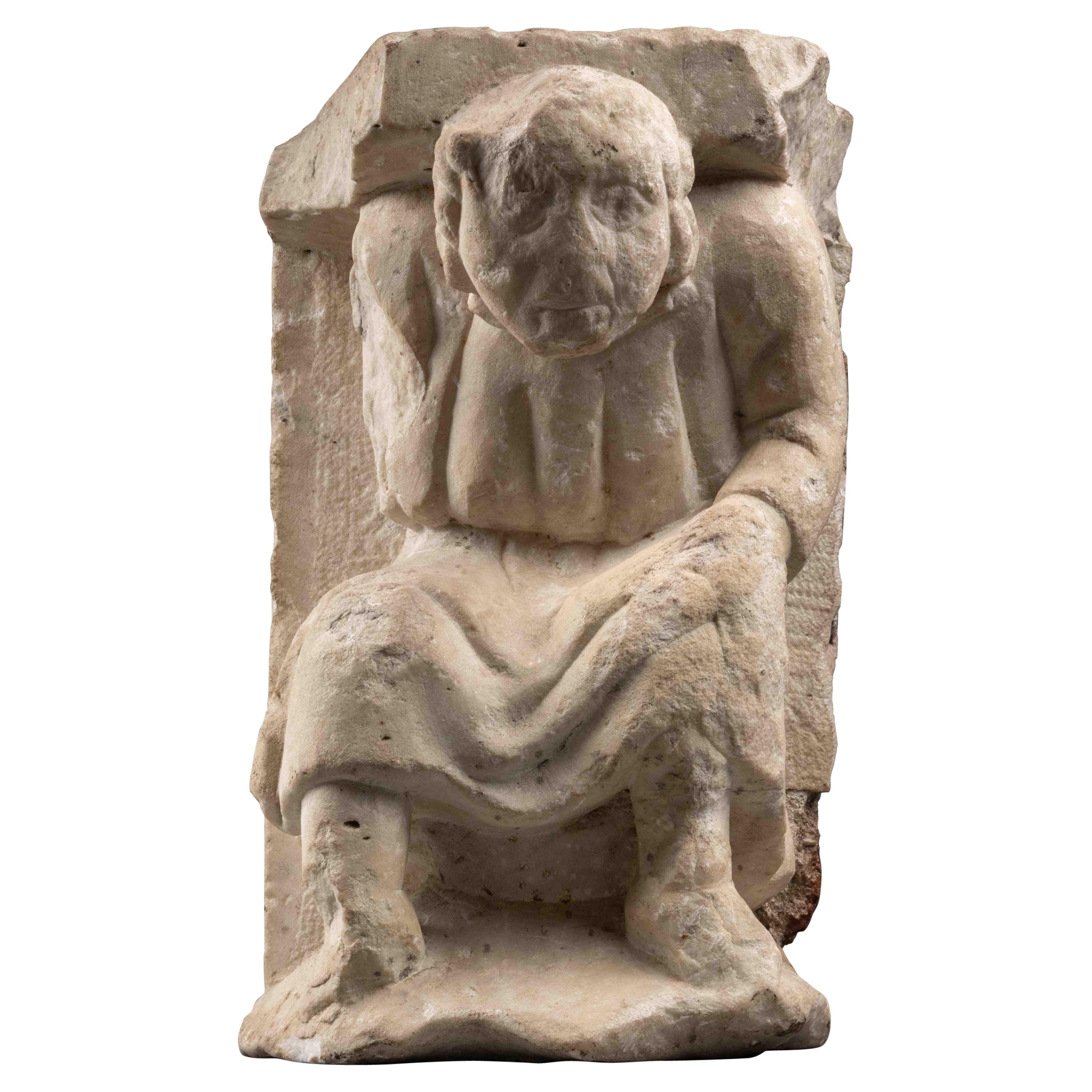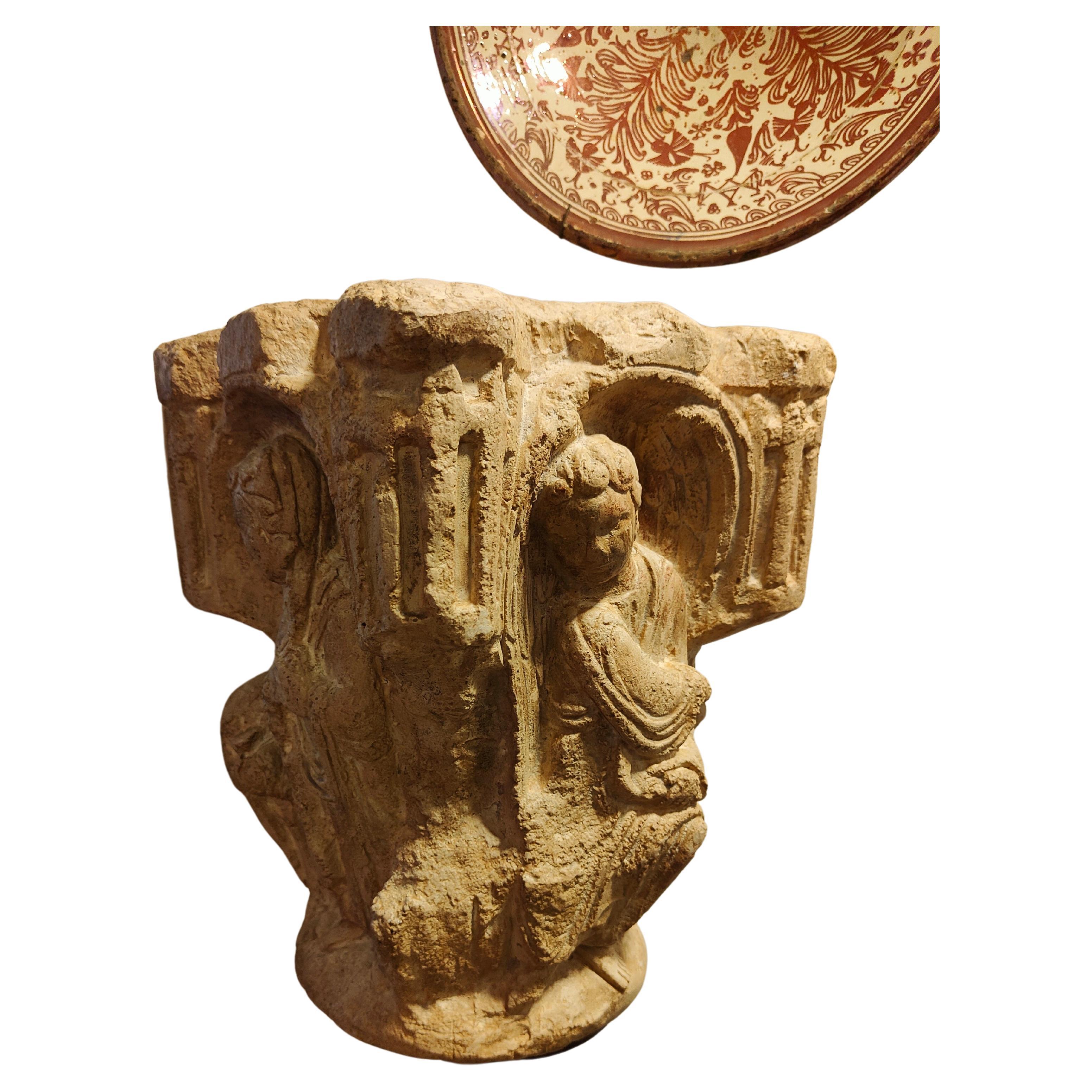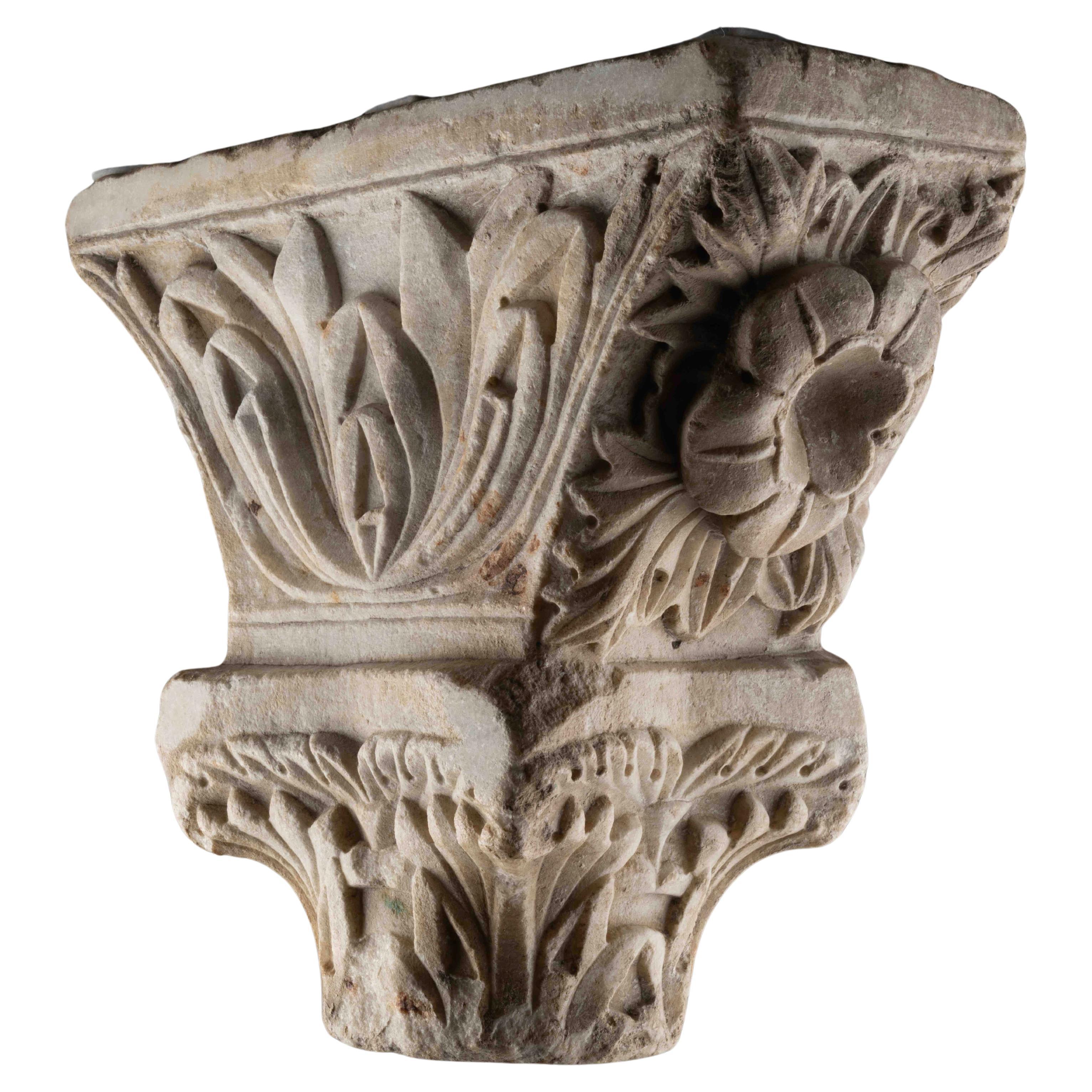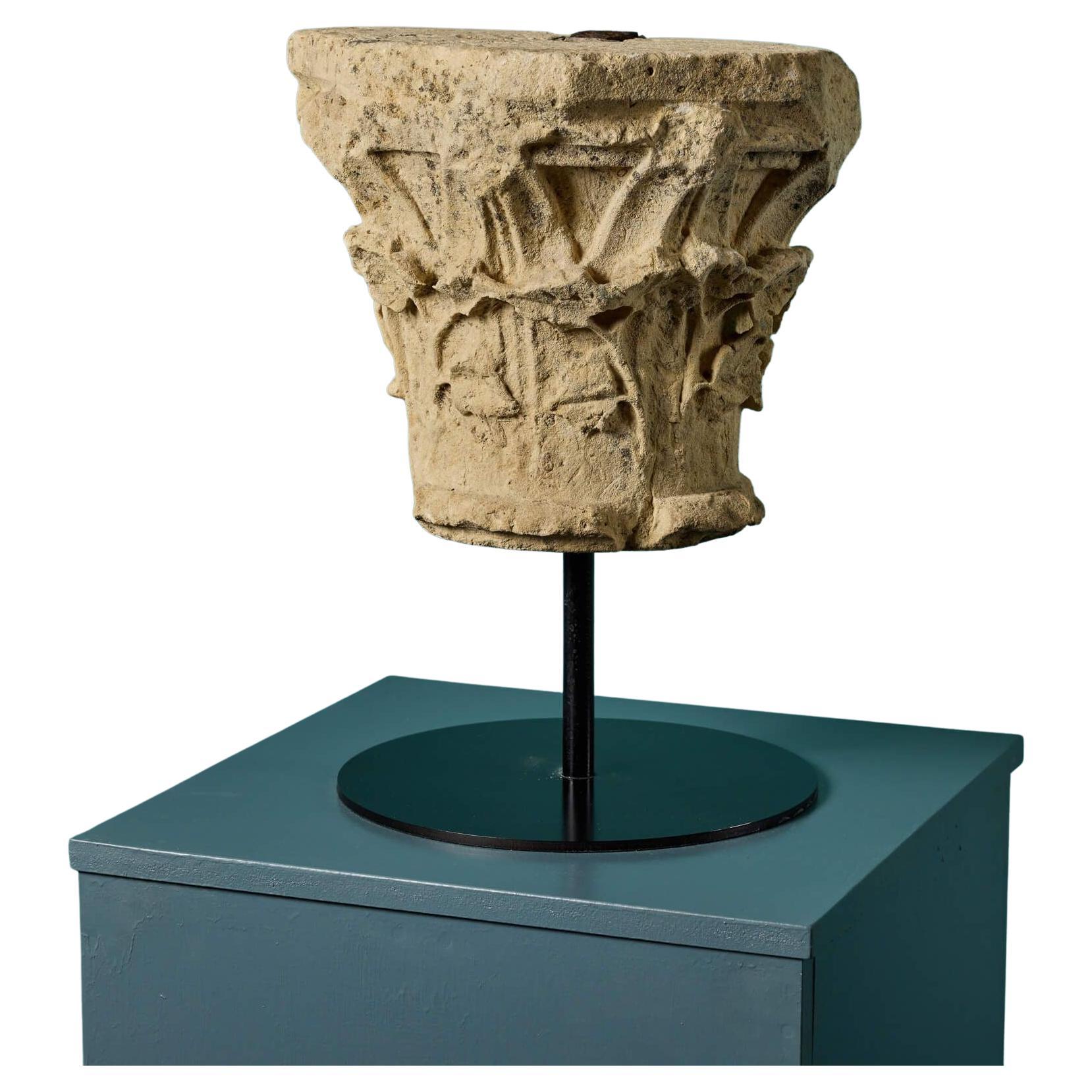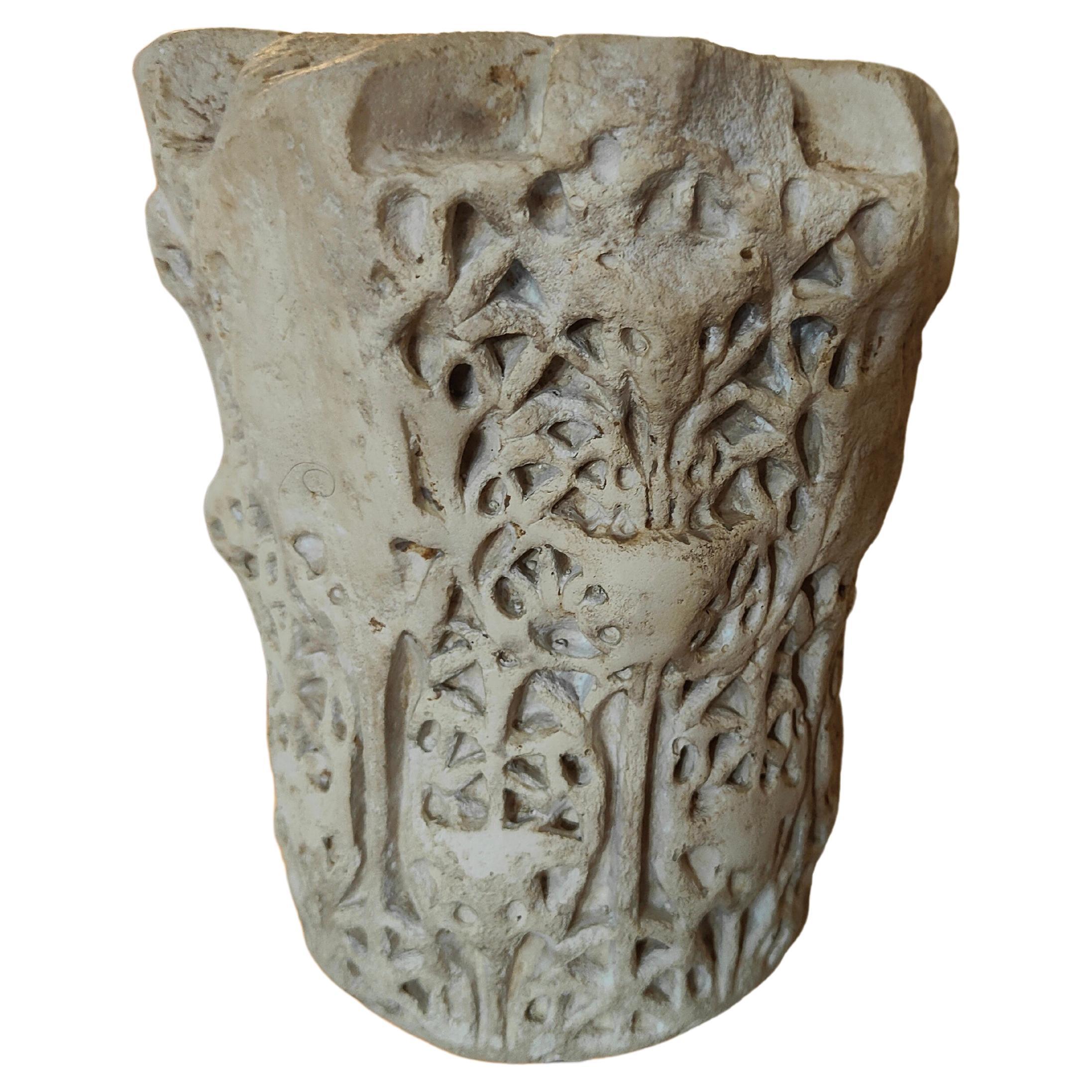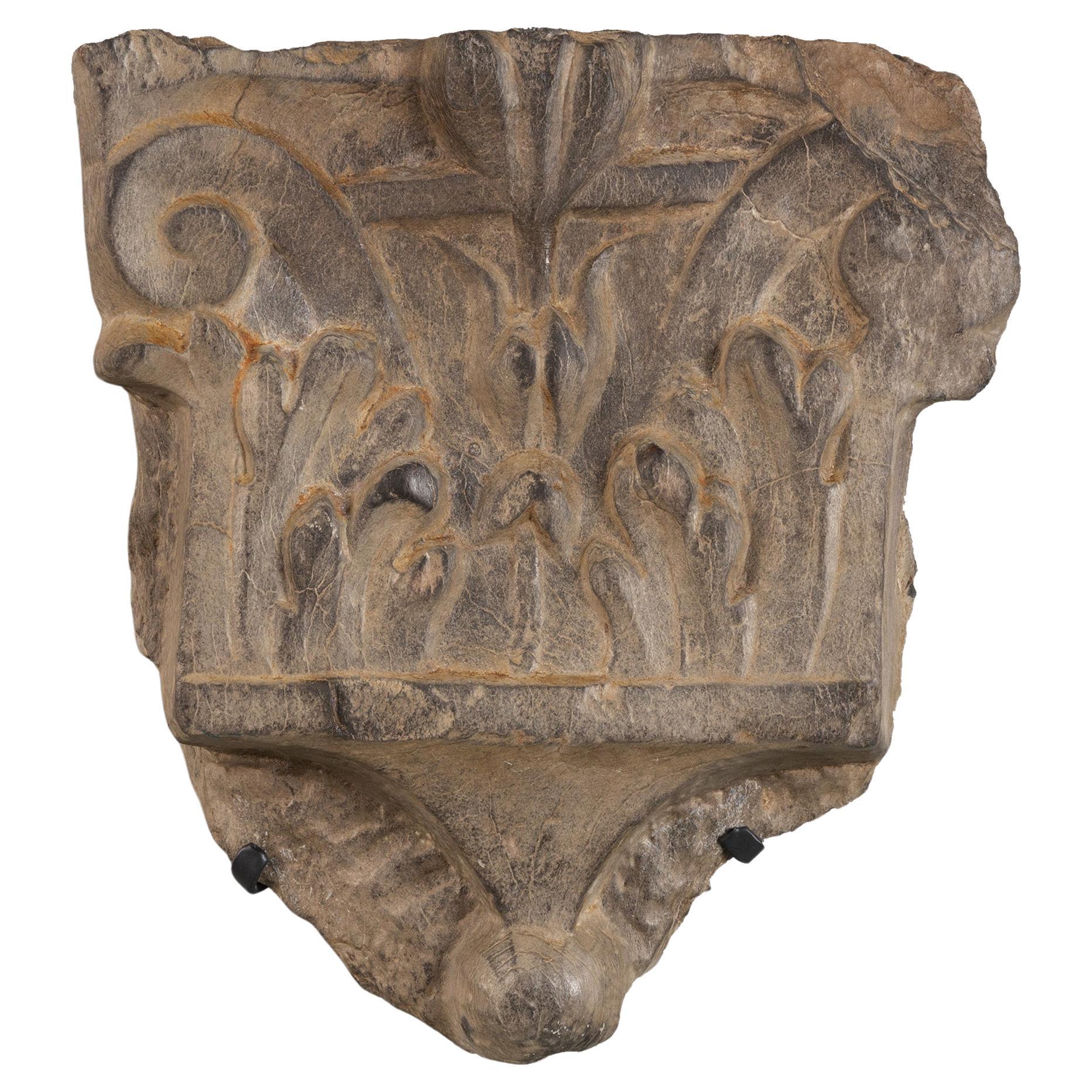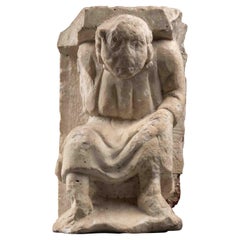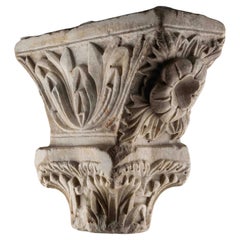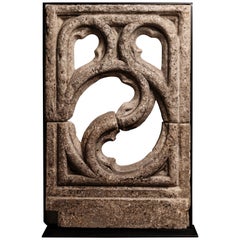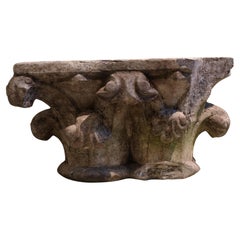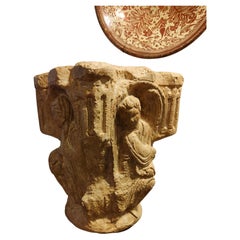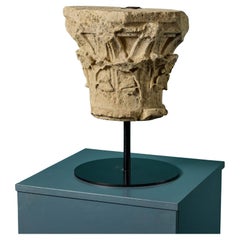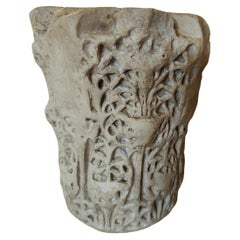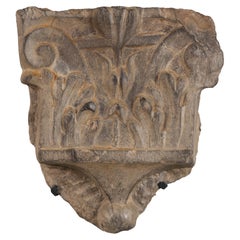Items Similar to Rare Romanesque Capital Depicting Four Africans, Apulia, 13th Century
Want more images or videos?
Request additional images or videos from the seller
1 of 6
Rare Romanesque Capital Depicting Four Africans, Apulia, 13th Century
$21,815.87
$27,269.8420% Off
£16,281.06
£20,351.3220% Off
€18,400
€23,00020% Off
CA$30,459.28
CA$38,074.1020% Off
A$33,221.13
A$41,526.4120% Off
CHF 17,466.31
CHF 21,832.8920% Off
MX$401,866.11
MX$502,332.6420% Off
NOK 217,957.77
NOK 272,447.2120% Off
SEK 205,949.38
SEK 257,436.7220% Off
DKK 140,117.21
DKK 175,146.5120% Off
About the Item
Large stone capital carved on each side in strong relief. The basket is covered with two crowns of vertical acanthus leaves which sprout from the astragal and fill the space between the human heads which decorates each side; each angle is underlined by a volute which accentuates the square format. The motif of heads emerging from foliage follows a well-established late Roman tradition, of which examples are still found in Apulia.
The four heads, carved in high relief, have facial features that identify them as black Africans : they have full lips, wide noses and the tightly curled hair covers only the upper part of their ears; they have closely set eyes, with convex eyeballs.
The creator of the capital actually knew black people: the difference in hairstyle, one with braided hair, the other with hair in small curls is a particularly naturalistic touch which falls outside the limits of the accepted medieval stereotype of black Africans.
One of the important achievement of visual art in the west during medieval period was the rediscovery of an effective means of depicting human racial variation.
There was in Apulia ample opportunity for the study of the appearance of African Saracens and in the late 12th century positive images of black Africans began to increase. This phenomenon was encouraged by a developing interest in blacks on the part of the Hohenstaufen emperors Henry VI and Frederick II. Henry's conquest of Sicily in the 1190s brought a number of black Moslems under his rule, and miniatures from the period record this fact. Also, the court of Frederick II of Hohenstaufen (1194–1250), a center of intellectual exchange in his time, shows black Africans in an array of positions that would later recur in Renaissance and Baroque court culture. In the 1220s Frederick, the German king, Roman emperor (from 1220), and successor of the Norman kings in Sicily, established an Islamic colony which included a number of blacks at Lucera in Apulia, and at least three sculptures can be associated with these Africans. One is a capital from Troia depicting a remarkably naturalistic black as well as other varied ethnic types. The second is the four-headed capital at the Metropolitan Museum of Art. The third work is a portrait of Johannes Maurus, a black who was Frederick's chamberlain.
Those sculptures signify more than a record of the Black presence in southern Italy at this time. The representation of Africans was new to the art of Apulia and even after the fall of the Hohenstaufen, artists made repeated references to the family's fondness for black people in art and in life. The two blacks who appear in the Adoration of the Magi on Nicola Pisano's Siena pulpit are undoubtedly based on African retainers at the Hohenstaufen court.
Clearly our capital and the one at the Metropolitan Museum of Art as well as the capital from Troia are associated by subject matter and, to a degree, by style. The unusual iconography suggest that our capital is the product of a very peculiar cultural back ground which can be found in the cosmopolitan atmosphere of 13th century South of Italy.
Bibliography:
David Abulafia, Frederick II: A Medieval Emperor,Oxford University Press, 1988
Henri Bresc, « Frédéric II et l’Islam », dans Anne-Marie Flambard Héricher (dir.), Frédéric II (1194-1250) et l’héritage normand de Sicile, Caen : Presses universitaires de Caen, 2001
Sam Fogg, architecture & ornament, 22 October - 19 November 2020, London
Sylvain Gouguenheim, Frédéric II, un empereur de légende, Paris, Perrin, 2015
Paul H. D. Kaplan. “Black Africans in Hohenstaufen Iconography.” Gesta, vol. 26, no. 1, [University of Chicago Press, International Center of Medieval Art], 1987, pp. 29–36
Ostoia Vera K. ‘To Represent What Is as It Is.’” The Metropolitan Museum of Art Bulletin, vol. 23, no. 10, The Metropolitan Museum of Art, 1965, pp. 367–72
Dorothea Weltecke, « Emperor Frederick II, « Sultan of Lucera », « Friend of the Muslims », promoter of cultural transfer : controversies and suggestions », dans Jorg Feuchter (dir.), Cultural Transfers in Dispute: Representations in Asia, Europe and the Arab World since the Middle Ages, Chicago, University of Chicago Press, 2011.
- Dimensions:Height: 13.78 in (35 cm)Width: 16.15 in (41 cm)Depth: 16.15 in (41 cm)
- Style:Medieval (Of the Period)
- Materials and Techniques:
- Place of Origin:
- Period:
- Date of Manufacture:13th Century
- Condition:Minor losses.
- Seller Location:Bruxelles, BE
- Reference Number:1stDibs: LU6666231859242
About the Seller
5.0
Vetted Professional Seller
Every seller passes strict standards for authenticity and reliability
1stDibs seller since 2022
15 sales on 1stDibs
Typical response time: <1 hour
- ShippingRetrieving quote...Shipping from: Bruxelles, Belgium
- Return Policy
Authenticity Guarantee
In the unlikely event there’s an issue with an item’s authenticity, contact us within 1 year for a full refund. DetailsMoney-Back Guarantee
If your item is not as described, is damaged in transit, or does not arrive, contact us within 7 days for a full refund. Details24-Hour Cancellation
You have a 24-hour grace period in which to reconsider your purchase, with no questions asked.Vetted Professional Sellers
Our world-class sellers must adhere to strict standards for service and quality, maintaining the integrity of our listings.Price-Match Guarantee
If you find that a seller listed the same item for a lower price elsewhere, we’ll match it.Trusted Global Delivery
Our best-in-class carrier network provides specialized shipping options worldwide, including custom delivery.More From This Seller
View AllRomanesque Telamon - Northern Italy, late 12th (Reemployed Roman marble)
Located in Bruxelles, BE
Telamon
Northern Italy, late 12th - early 13th century
Reemployed Roman marble
H 32 x L 18 x P 17 cm
« Sono coloro che hanno dimenticato che l’uomo é solo un bruco, destinato a dive...
Category
Antique 15th Century and Earlier Italian Medieval Figurative Sculptures
Materials
Marble
$23,712 Sale Price
20% Off
Marble capital carved with acanthus leaves - Apulia, 13th century
Located in Bruxelles, BE
Marble capital carved with acanthus leaves
Southern Italy, Apulia
13th century
28,5 x 53,5 x 12,5 cm
This wedge-shape capital decorated with acanthus leaves and roses is character...
Category
Antique 15th Century and Earlier Italian Medieval Architectural Elements
Materials
Marble
Carved Limestone Balustrade, North of France, First Half of the 15th Century
Located in Bruxelles, BE
Carved Limestone balustrade.
In a modern metal frame.
North of France, Ile de France or Normandy.
End of the 14th century - first half of the 15th century.
Measures: 90 x 62 x 8...
Category
Antique 15th Century and Earlier French Medieval Architectural Elements
Materials
Limestone
$14,227 Sale Price
20% Off
double capital - french, end of 13th century
Located in Bruxelles, BE
Double capital with hook decorations
Grey stone
France, 13th century
Reduced—cut in the back in modern times
H 22 x L 41 x P 20 cm
'Hook' is the name given today to these ornamen...
Category
Antique 15th Century and Earlier French Medieval Architectural Elements
Materials
Stone
$1,659 Sale Price
22% Off
Marble Roman relief representing a Christogram
Located in Bruxelles, BE
Marble Roman relief representing a Christogram
Roman relief - 4th century
25 x 22 x 8 cm
Provenance :
Collection of the Château de B. À Nevers by Georges C.S., scholar born in 1833 and deceased in 1909
The entire castle and its collections were acquired in 1938 by the current owners of the estate
A christogram is a monogram or combination of letters that forms an abreviation for the name of Jesus Christ.
This rare fragment combines chi (X) and rho (P), the first two letters of Christ's name in Greek and it is one of the oldest and most popular early christian symbol. The monogram of Christ, or chrismon, is also a powerful symbol of imperial victory: it appeared to Emperor Constantine the Great before his battle against Maxentius in ad 312, promising victory in the name of Christ. In Plato's Timaeus, it is explained that the two bands which form the "world soul" (anima mundi...
Category
Antique 15th Century and Earlier Italian Classical Roman Figurative Scul...
Materials
Marble
$3,481 Sale Price
30% Off
Large Hexagonale Base of Pilaster in Burgundy Stone, Burgundy, 15th Century
Located in Bruxelles, BE
Large base of molded hexagonal pilaster in burgundy stone carved with vines, grapes and rosettes in high relief.
Burgundy, 15th century
28 x 63 x 30 cm
Provenance : collection De...
Category
Antique 15th Century and Earlier French Gothic Architectural Elements
Materials
Stone
$6,165 Sale Price
20% Off
You May Also Like
Antique STONE Capital in ROMAN Style
Located in Madrid, ES
Add a touch of historical elegance to your collection with this antique stone capital. Featuring intricate roman designs, this piece is a beautif...
Category
Antique 1890s Mounted Objects
Materials
Stone
Rare English Romanesque Limestone Capital on Stand
Located in Wormelow, Herefordshire
This weathered English Romanesque limestone capital is centuries old, dating from the Norman era of the 11th and 12th centuries. Originating from Oxf...
Category
Antique 15th Century and Earlier English Medieval Mounted Objects
Materials
Stone, Limestone
Antique Terracotta Capital in Arabesque Style
Located in Madrid, ES
Add a touch of historical elegance to your collection with this antique terracotta capital. Featuring intricate Arabesque designs, this piece is a b...
Category
Antique 1890s Mounted Objects
Materials
Terracotta
16th Century Ligurian Stone Half-Capital
Located in London, GB
A rare 16th Century Italian stone Corinthian half-capital, carved in Ligurian slate, mounted on a simple wrought iron bracket for wall hanging.
Category
Antique 16th Century Italian Renaissance Wall-mounted Sculptures
Materials
Slate, Iron
Decorative Romanesque Capital in Terracotta – 1950s
Located in Madrid, ES
This exquisite decorative Romanesque capital, crafted from terracotta or a similar material in the 1950s, is a stunning piece that beautifully encapsulates the artistry of medieval a...
Category
Mid-20th Century Mounted Objects
Materials
Terracotta
Italian Medieval Romanesque Carved Marble Capital Fragment
Located in Buisson, FR
Rare and beautiful small medieval treasure.
Hand carved Romanesque marble capital,
Italy, circa 1250-1400.
Weathered, small losses.
More photo's avai...
Category
Antique 15th Century and Earlier Italian Medieval Architectural Elements
Materials
Marble
$1,156 Sale Price
45% Off
More Ways To Browse
The Capital
13th Century
Frederick Ii
13th Century Furniture
Romanesque Furniture
Henry Vi
Stone Capital
Rare African Art
Antique Stone Capital
African Carved Stone
Medieval Capital
Romanesque Capital
French Architectural Fragment
Antique Floral Tiles
Mid Century Architectural Panels
Vintage Architectural Salvage
Midcentury Door Knocker
Stone Carved Coat Of Arms
